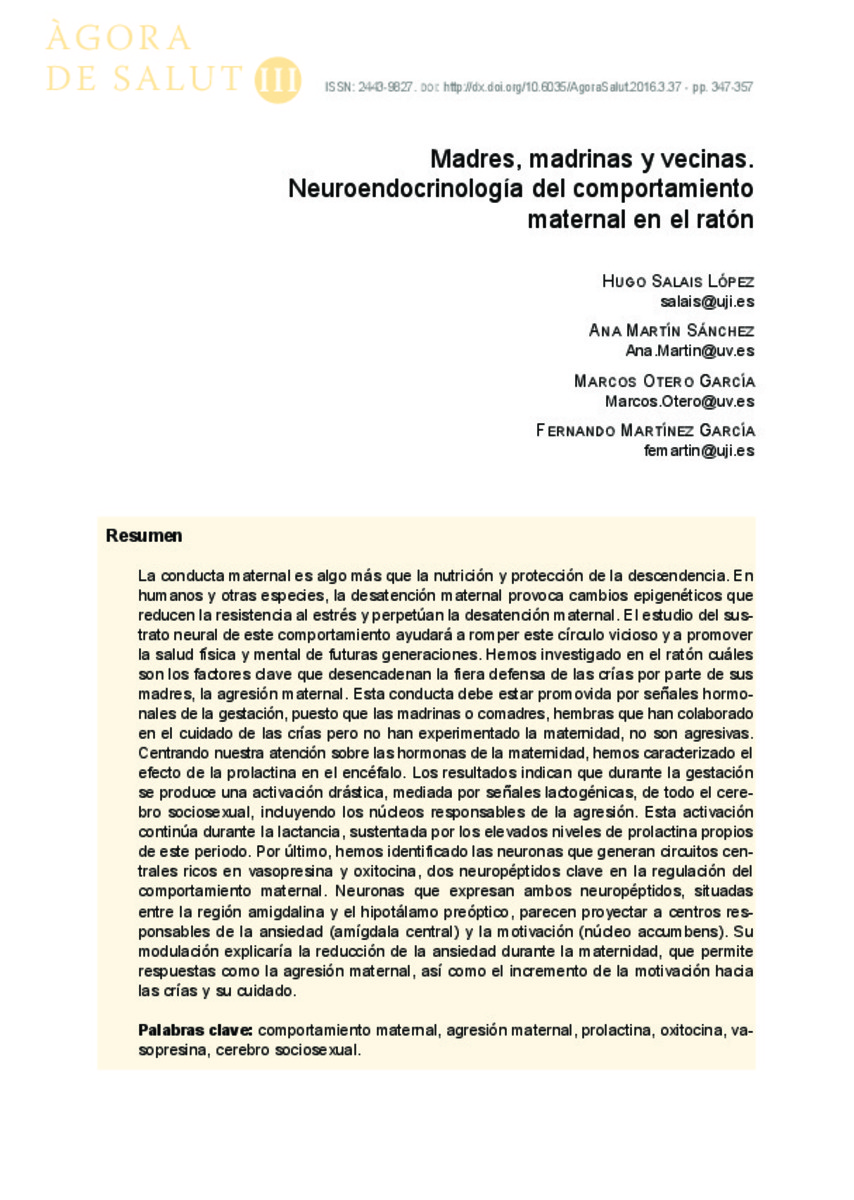Mostrar el registro sencillo del ítem
Madres, Madrinas y Vecinas. Neuroendocrinología del comportamiento maternal en el ratón.
| dc.contributor.author | Salais López, Hugo | |
| dc.contributor.author | Martín Sánchez, Ana | |
| dc.contributor.author | Otero García, Marcos | |
| dc.contributor.author | Martinez-Garcia, Fernando | |
| dc.date.accessioned | 2016-03-30T10:31:22Z | |
| dc.date.available | 2016-03-30T10:31:22Z | |
| dc.date.issued | 2016 | |
| dc.identifier.issn | 2443-9827 | |
| dc.identifier.uri | http://hdl.handle.net/10234/155768 | |
| dc.description.abstract | La conducta maternal es algo más que la nutrición y protección de la descendencia. En humanos y otras especies, la desatención maternal provoca cambios epigenéticos que reducen la resistencia al estrés y perpetúan la desatención maternal. El estudio del sustrato neural de este comportamiento ayudará a romper este círculo vicioso y a promover la salud física y mental de futuras generaciones. Hemos investigado en el ratón cuáles son los factores clave que desencadenan la fiera defensa de las crías por parte de sus madres, la agresión maternal. Esta conducta debe estar promovida por señales hormonales de la gestación, puesto que las madrinas o comadres, hembras que han colaborado en el cuidado de las crías pero no han experimentado la maternidad, no son agresivas. Centrando nuestra atención sobre las hormonas de la maternidad, hemos caracterizado el efecto de la prolactina en el encéfalo. Los resultados indican que durante la gestación se produce una activación drástica, mediada por señales lactogénicas, de todo el cerebro sociosexual, incluyendo los núcleos responsables de la agresión. Esta activación continúa durante la lactancia, sustentada por los elevados niveles de prolactina propios de este periodo. Por último, hemos identificado las neuronas que generan circuitos centrales ricos en vasopresina y oxitocina, dos neuropéptidos clave en la regulación del comportamiento maternal. Neuronas que expresan ambos neuropéptidos, situadas entre la región amigdalina y el hipotálamo preóptico, parecen proyectar a centros responsables de la ansiedad (amígdala central) y la motivación (núcleo accumbens). Su modulación explicaría la reducción de la ansiedad durante la maternidad, que permite respuestas como la agresión maternal, así como el incremento de la motivación hacia las crías y su cuidado. | ca_CA |
| dc.description.abstract | Maternal behaviour is not limited to the nourishment and protection of the offspring. In humans as in other species, maternal neglect induces epigenetic modifications that compromise resilience to stress and perpetuate inattention. The study of the neural substrate of this behaviour will help to break this vicious cycle and to promote physical and mental health of future generations. We have explored which are the key factors, in the mouse, that trigger in the mother the fierce defence of the pups from external threats, maternal aggression. This behaviour must be promoted by the hormonal cues of the maternal period, since godmothers, females that shared pup care with the mother, but have not undergone motherhood, are not aggressive. Focusing on important hormonal signals during this period, we have characterised the central effect of prolactin, the maternal hormone. Our results indicate that, during pregnancy, lactogenic signals exert a drastic activation of the sociosexual brain, including centres responsible for aggression. These activation continues during lactation, hosted by the elevated levels of prolactin during this period. Lastly, we have identified the neurons generating central circuits rich in vasopressin and oxytocin, two neuropeptides with a key role in the regulation of maternal behaviour. Neurons expressing both neuropeptides and located between the amygdaloid region and preoptic hypothalamus, project to neural centres responsible for anxiety behaviour (central tonsil) and motivation (nucleus accumbens). The modulation of these sites would explain the reduction of anxiety during the motherhood, which ensures behaviours like maternal aggression, as well as the increase in pup-directed motivated behaviours. | ca_CA |
| dc.format.extent | 11 p. | ca_CA |
| dc.format.mimetype | application/pdf | ca_CA |
| dc.language.iso | spa | ca_CA |
| dc.publisher | Universitat Jaume I | ca_CA |
| dc.relation.isPartOf | Àgora de salut vol. III | ca_CA |
| dc.rights | © Del text: els autors i les autores, 2016 © D’aquesta edició: Publicacions de la Universitat Jaume I, 2016 | ca_CA |
| dc.rights.uri | http://creativecommons.org/licenses/by-sa/4.0/ | * |
| dc.subject | comportamiento maternal | ca_CA |
| dc.subject | agresión maternal | ca_CA |
| dc.subject | prolactina | ca_CA |
| dc.subject | oxitocina | ca_CA |
| dc.subject | vasopresina | ca_CA |
| dc.subject | cerebro sociosexual | ca_CA |
| dc.subject | maternal care | ca_CA |
| dc.subject | maternal aggression | ca_CA |
| dc.subject | prolactin | ca_CA |
| dc.subject | oxytocin | ca_CA |
| dc.subject | vasopressin | ca_CA |
| dc.subject | sociosexual brain | ca_CA |
| dc.title | Madres, Madrinas y Vecinas. Neuroendocrinología del comportamiento maternal en el ratón. | ca_CA |
| dc.type | info:eu-repo/semantics/article | ca_CA |
| dc.identifier.doi | http://dx.doi.org/10.6035/AgoraSalut.2016.3.37 | |
| dc.rights.accessRights | info:eu-repo/semantics/openAccess | ca_CA |










